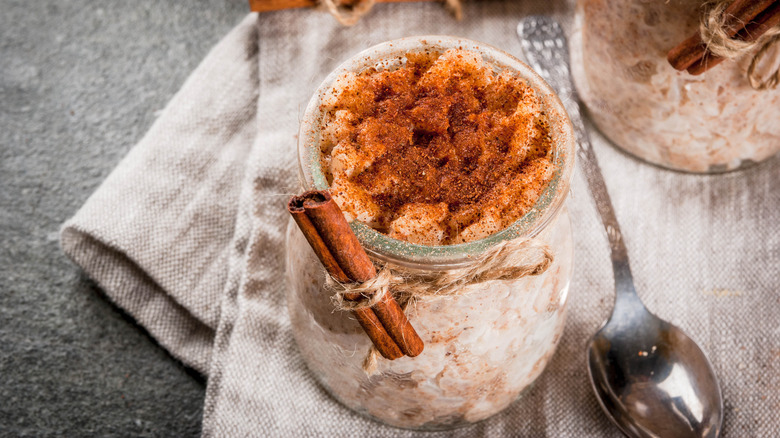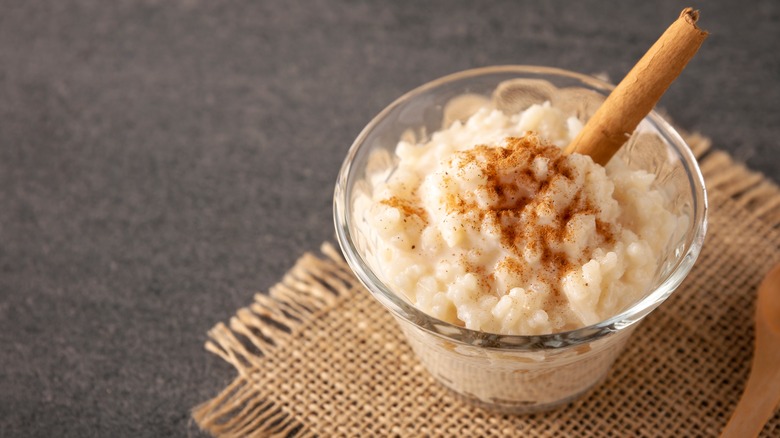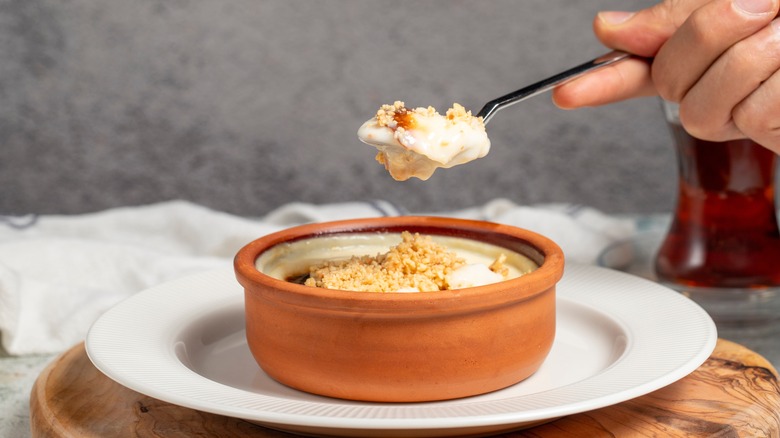Arroz Doce Vs American Rice Pudding: What's The Difference?
Some of the best dishes shine due to their simplicity, imbuing a magical quality that transports an eater right back to their early years. Take a simple grilled cheese and tomato soup, or a comforting and easy chicken noodle. In the dessert category, such a candidate is the creamy, sweetened and spiced rice pudding.
There's nothing childish about the dish; rather it has a deep-rooted appeal that's been savored for a long time. Hence, it has been found for centuries all over the world, with a version specific to Portugal, too: arroz doce. Compared to the old-school classic we call American rice pudding, the dish is surprisingly similar. It's also made with rice that's cooked down until broken, thickened, and tied together with delicious sweet flavors.
However, the Portuguese craft their arroz doce with a dependable consistency, relying on a specific rice variety called carolino, and seldom experiment with new flavors. It's a contrast to the highly variable American rice pudding, which can even pack in ingredients like liquor, raisins, and yogurt, and uses variations on the rice's grain type. Not to mention, the stateside version is sometimes turned into a casserole. Yet take a bite, and the sensations undoubtedly overlap, so there's lots to examine in the details.
What is arroz doce?
Arroz doce is one of the most traditional Portuguese desserts, frequently home-cooked during holidays, long lunches, and other festive events. It's a comforting dish that consists of short-grain rice that's prepared to a very creamy consistency, sweetened with sugar, and flavored with cinnamon and lemon. Cooks either boil the rice in water first, and then fold in further ingredients, or directly cook the grains in spiced milk. To further amplify the custardy texture, egg yolks are added at the end of the preparation. Plus, this introduction lends to the dish a pleasant yellow hue, as also observed in Portugal's unique pastel de nata. Unlike this baked good, arroz doce is enjoyed right after preparation, although some also refrigerate it and eat it once cooled.
The dish's creation traces back to the Moorish influence on the country, which started in the 8th century. At first, rice was only accessible to wealthy citizens, but centuries later — by around the 18th century — it became common fare. It was during this time that arroz doce emerged. Since then, it hasn't waned in popularity and carries allusions of a warm and festive spirit similar to Britain's Christmas pudding.
What is American rice pudding?
Comforting and easy to make, American rice pudding is a dish that's both ubiquitous yet still underappreciated. It follows a similar preparation to arroz doce, with the rice simmered in either water or a spiced milk mixture, before the integration of thickeners such as egg yolks, heavy cream, butter, and sometimes even yogurt. Unlike other rice pudding renditions, the American version favors long rice grains. As a result, there's some variation in the consistency; some pudding renditions turn out more grainy, while others are cooked down until smooth.
While stove preparations are common, the American version also has recipes for a baked rice pudding. This style combines the same assortment of ingredients but instead prepares the dish in a wide casserole pan. This eliminates the need for stirring and creates a delectable cinnamon crust, which adds some flavor and visual appeal. Americans then spoon out the pudding mixture, either hot or cold, into a serving vessel with some garnishes on top.
American rice pudding comes in more variations
Rice pudding's simple preparation allows for many variations, particularly in the American dish. Although long grain rice'sless starchy character is common, it's not a strict requirement — arborio, sushi, and other short-grain rice are utilized, too. In fact, it's even possible to make rice pudding with leftover rice. On the contrary, arroz doce settles on exclusively short-grain rice, specifically the carolino variety, which is one of Portugal's two native varieties.
When it comes to flavors, arroz doce preparations keep it straightforward, with recipes nearly always relying on the familiar pairing, perhaps only adding a flourish with a vanilla pod. Meanwhile, the American version employs a broader flavoring palate, using everything from nutmeg, cloves, and varying citrus zest for added aroma. Raisins, in all of their varieties, are another especially common ingredient. And some might even integrate unique regional takes like bourbon or rum. Plus, even the fattening components cover a wider range, with yogurt, cream, butter, and evaporated milk. So if you're wanting to experiment with your flavors, rely on an American rice pudding template.
Both dishes stem from a common history
Despite being enjoyed thousands of miles apart, the two dishes are remarkably similar. Both rely on the foundational rice, eggs, and milk to craft a delightfully comforting dish. And even the seasonings overlap; cinnamon is a common addition to both. It's all due to the fact that both puddings have a shared origin — they emerge from a culinary tradition passed along the Silk Road.
Some speculate a sweetened rice pudding may have emerged as early as 6,000 B.C. in India. In China, the preparation of classic congee dates back to 1000 B.C. Coincidentally, the Portuguese were the first European nation to document this version's preparation. However, it was along transcontinental trade routes that rice pudding spread West. And once rice became more accessible, it quickly established itself in this sweet form.
The first sugary rice pudding appeared in England in a 14th-century cookbook, before arroz doce became popular in Portugal. Varying spices — especially cinnamon — were quickly integrated into early versions. Rice came to America by way of the British, but only became agriculturally feasible due to the African slave trade. With most plantations based in the South, it more strongly integrated into the region's diet. Hence, renditions of specifically Southern rice pudding are a bit more common. And today, both the Portuguese and American interpretations still thrive — after all, why change a tried formula?




